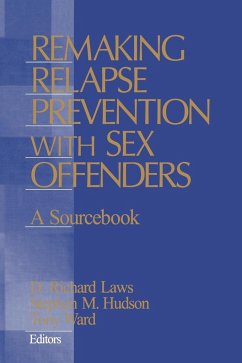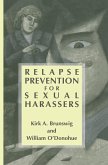D Richard Laws / Stephen M. Hudson / Tony Ward (eds.)A Sourcebook
Remaking Relapse Prevention with Sex Offenders
A Sourcebook
Herausgeber: Laws, D. Richard; Hudson, Stephen M.; Ward, Tony
D Richard Laws / Stephen M. Hudson / Tony Ward (eds.)A Sourcebook
Remaking Relapse Prevention with Sex Offenders
A Sourcebook
Herausgeber: Laws, D. Richard; Hudson, Stephen M.; Ward, Tony
- Gebundenes Buch
- Merkliste
- Auf die Merkliste
- Bewerten Bewerten
- Teilen
- Produkt teilen
- Produkterinnerung
- Produkterinnerung
Remaking Relapse Prevention With Sex Offenders is a comprehensive resource of the most current and practical information about working with sex offenders to prevent relapse.
Andere Kunden interessierten sich auch für
![Relapse Prevention for Sexual Harassers Relapse Prevention for Sexual Harassers]() Kirk A. BrunswigRelapse Prevention for Sexual Harassers62,99 €
Kirk A. BrunswigRelapse Prevention for Sexual Harassers62,99 €![Treating Adult and Juvenile Offenders with Special Needs Treating Adult and Juvenile Offenders with Special Needs]() Jose B. AshfordTreating Adult and Juvenile Offenders with Special Needs25,99 €
Jose B. AshfordTreating Adult and Juvenile Offenders with Special Needs25,99 €![Disulfiram Disulfiram]() Avinash De SousaDisulfiram81,99 €
Avinash De SousaDisulfiram81,99 €![Sex Offenders Sex Offenders]() Arjan A J BloklandSex Offenders68,99 €
Arjan A J BloklandSex Offenders68,99 €![Relapse Prevention for Addictive Behaviours Relapse Prevention for Addictive Behaviours]() S. WanigaratneRelapse Prevention for Addictive Behaviours63,99 €
S. WanigaratneRelapse Prevention for Addictive Behaviours63,99 €![The Wiley Handbook on What Works for Offenders with Intellectual and Developmental Disabilities The Wiley Handbook on What Works for Offenders with Intellectual and Developmental Disabilities]() The Wiley Handbook on What Works for Offenders with Intellectual and Developmental Disabilities54,99 €
The Wiley Handbook on What Works for Offenders with Intellectual and Developmental Disabilities54,99 €![Treating Sex Offenders Treating Sex Offenders]() Jill D StinsonTreating Sex Offenders65,99 €
Jill D StinsonTreating Sex Offenders65,99 €-
-
-
Remaking Relapse Prevention With Sex Offenders is a comprehensive resource of the most current and practical information about working with sex offenders to prevent relapse.
Hinweis: Dieser Artikel kann nur an eine deutsche Lieferadresse ausgeliefert werden.
Hinweis: Dieser Artikel kann nur an eine deutsche Lieferadresse ausgeliefert werden.
Produktdetails
- Produktdetails
- Verlag: Sage Publications, Inc.
- Seitenzahl: 576
- Erscheinungstermin: 1. Januar 2000
- Englisch
- Abmessung: 260mm x 183mm x 35mm
- Gewicht: 1264g
- ISBN-13: 9780761918875
- ISBN-10: 0761918876
- Artikelnr.: 22178245
- Herstellerkennzeichnung
- Libri GmbH
- Europaallee 1
- 36244 Bad Hersfeld
- gpsr@libri.de
- Verlag: Sage Publications, Inc.
- Seitenzahl: 576
- Erscheinungstermin: 1. Januar 2000
- Englisch
- Abmessung: 260mm x 183mm x 35mm
- Gewicht: 1264g
- ISBN-13: 9780761918875
- ISBN-10: 0761918876
- Artikelnr.: 22178245
- Herstellerkennzeichnung
- Libri GmbH
- Europaallee 1
- 36244 Bad Hersfeld
- gpsr@libri.de
D.Richard Laws, PhD, was the director of the Sexual Behavior Laboratory at Atascadero State Hospital in California from 1970-1985; project director at the Florida Mental Health Institute, Tampa, from 1985-1989; manager of forensic psychology at Alberta Hospital, Edmonton, Alberta from 1989-1994; and most recently a psychologist with Adult Forensic Psychiatric Services in Victoria, British Columbia from 1994 until his retirement in 1999. Dr. Laws is known in the field of sexual deviation as a developer of assessment procedures and in program development and evaluation. He is the author of numerous articles and book chapters in this area and serves on the editorial board of several journals. He is the editor of Relapse Prevention with Sex Offenders (1989), co-editor with W.L. Marshall and H.E. Barbaree of Handbook of Sexual Assault (1990), co-editor with W.T. O'Donohue of Sexual Deviance (1997), and co-editor with S.M. Hudson and T. Ward of Remaking Relapse Prevention with Sex Offenders (2000). He is past president of the Association for the Treatment of Sexual Abusers. He is adjunct faculty at the University of Victoria and Simon Fraser University in British Columbia and is Honorary Professor at the University of Birmingham (UK) and Cardiff University (UK).
PART ONE: RELAPSE PREVENTION IN HISTORICAL PERSPECTIVE The Original Model of Relapse Prevention with Sex Offenders - D R Laws, Stephen M Hudson and Tony Ward Promises Unfulfilled PART TWO: A REVISIONIST CRITIQUE What Is so Special about Relapse Prevention? - R Karl Hanson Do Relapse Prevention Components Enhance Treatment Effectiveness? - W L Marshall and Dana Anderson Relapse Prevention and Harm Reduction - Susan A Stoner and William H George Areas of Overlap PART THREE: CONCEPTUAL AND CLINICAL REVISIONS A Self-Regulation Model of Relapse Prevention - Tony Ward and Stephen M Hudson Relapse Prevention - Stephen M Hudson and Tony Ward Assessment and Treatment Implications Behavioral Economics - William O
Donohue, Tamara Penix and Erin Oksol Understanding Sexual Behavior, Preference and Self-Control PART FOUR: CLINICAL INNOVATIONS: ASSESSMENT AND TREATMENT Empathy Inhibition, Intimacy Deficits and Attachment Difficulties in Sex Offenders - Kurt M Bumby The Role of Cognitive Distortions in Relapse Prevention Program - Calvin M Langton and W L Marshall Managing Resistance and Rebellion in Relapse Prevention Intervention - Ruth E Mann Complementing Relapse Prevention with Medical Intervention - Don Grubin Competency-Based Assessment - Michael H Miner Contextual Issues in Relapse Prevention Treatment - Yolanda M Fernandez and W L Marshall External Supervision - Georgia F Cumming and Robert J McGrath How Can It Increase the Effectiveness of Relapse Prevention PART FIVE: SEXUAL PREFERENCE ASSESSMENT Remaking Penile Plethysmography - Robert J Konopasky and Aaron W B Konopasky Polygraphy - Michael A O
Connell Assessment and Community Monitoring The Abel Screen - Lane Fischer A Non-Intrusive Alternative? PART SIX: PROGRAMS: MAJOR INTERVENTIONS USING RELAPSE PREVENTION Preventing Relapse in Sex Offenders - Janice K Marques et al What We Learned from SOTEP
s Experimental Treatment Program An Evidence-Based Relapse Prevention Program - Ruth E Mann and David Thornton PART SEVEN: RELAPSE PREVENTION APPLIED TO SPECIAL POPULATIONS Relapse Prevention with Adolescent Sex Offenders - William D Murphy and I Jacqueline Page Treatment of the Developmentally Disabled Sex Offender - James L Haaven and Emily M Coleman Relapse Prevention with Sexual Murderers - Joanna Clarke and Adam J Carter Replacing the Function of Abusive Behaviors for the Offender - Hilary Eldridge and Jacqui Sradjian Remaking Relapse Prevention in Working with Women Who Sexually Abuse Children Holism, Wellness and Spirituality - Lawrence Ellerby, Jacqueline Bedard and Shirl Chartrand Moving from Relapse Prevention to Healing PART EIGHT: THE BOTTOM LINE Maintaining Relapse Prevention Skills and Strategies in Treated Child Abusers - Anthony Beech and Dawn Fisher How Does Recidivism Risk Assessment Predict Survival? - Jean Proulx et al Treatment Outcome and Evaluation Problems (and Solutions) - R Karl Hanson PART NINE: THE WAY FORWARD Wither Relapse Prevention - Stephen M Hudson, Tony Ward and D Richard Laws
Donohue, Tamara Penix and Erin Oksol Understanding Sexual Behavior, Preference and Self-Control PART FOUR: CLINICAL INNOVATIONS: ASSESSMENT AND TREATMENT Empathy Inhibition, Intimacy Deficits and Attachment Difficulties in Sex Offenders - Kurt M Bumby The Role of Cognitive Distortions in Relapse Prevention Program - Calvin M Langton and W L Marshall Managing Resistance and Rebellion in Relapse Prevention Intervention - Ruth E Mann Complementing Relapse Prevention with Medical Intervention - Don Grubin Competency-Based Assessment - Michael H Miner Contextual Issues in Relapse Prevention Treatment - Yolanda M Fernandez and W L Marshall External Supervision - Georgia F Cumming and Robert J McGrath How Can It Increase the Effectiveness of Relapse Prevention PART FIVE: SEXUAL PREFERENCE ASSESSMENT Remaking Penile Plethysmography - Robert J Konopasky and Aaron W B Konopasky Polygraphy - Michael A O
Connell Assessment and Community Monitoring The Abel Screen - Lane Fischer A Non-Intrusive Alternative? PART SIX: PROGRAMS: MAJOR INTERVENTIONS USING RELAPSE PREVENTION Preventing Relapse in Sex Offenders - Janice K Marques et al What We Learned from SOTEP
s Experimental Treatment Program An Evidence-Based Relapse Prevention Program - Ruth E Mann and David Thornton PART SEVEN: RELAPSE PREVENTION APPLIED TO SPECIAL POPULATIONS Relapse Prevention with Adolescent Sex Offenders - William D Murphy and I Jacqueline Page Treatment of the Developmentally Disabled Sex Offender - James L Haaven and Emily M Coleman Relapse Prevention with Sexual Murderers - Joanna Clarke and Adam J Carter Replacing the Function of Abusive Behaviors for the Offender - Hilary Eldridge and Jacqui Sradjian Remaking Relapse Prevention in Working with Women Who Sexually Abuse Children Holism, Wellness and Spirituality - Lawrence Ellerby, Jacqueline Bedard and Shirl Chartrand Moving from Relapse Prevention to Healing PART EIGHT: THE BOTTOM LINE Maintaining Relapse Prevention Skills and Strategies in Treated Child Abusers - Anthony Beech and Dawn Fisher How Does Recidivism Risk Assessment Predict Survival? - Jean Proulx et al Treatment Outcome and Evaluation Problems (and Solutions) - R Karl Hanson PART NINE: THE WAY FORWARD Wither Relapse Prevention - Stephen M Hudson, Tony Ward and D Richard Laws
PART ONE: RELAPSE PREVENTION IN HISTORICAL PERSPECTIVE The Original Model of Relapse Prevention with Sex Offenders - D R Laws, Stephen M Hudson and Tony Ward Promises Unfulfilled PART TWO: A REVISIONIST CRITIQUE What Is so Special about Relapse Prevention? - R Karl Hanson Do Relapse Prevention Components Enhance Treatment Effectiveness? - W L Marshall and Dana Anderson Relapse Prevention and Harm Reduction - Susan A Stoner and William H George Areas of Overlap PART THREE: CONCEPTUAL AND CLINICAL REVISIONS A Self-Regulation Model of Relapse Prevention - Tony Ward and Stephen M Hudson Relapse Prevention - Stephen M Hudson and Tony Ward Assessment and Treatment Implications Behavioral Economics - William O
Donohue, Tamara Penix and Erin Oksol Understanding Sexual Behavior, Preference and Self-Control PART FOUR: CLINICAL INNOVATIONS: ASSESSMENT AND TREATMENT Empathy Inhibition, Intimacy Deficits and Attachment Difficulties in Sex Offenders - Kurt M Bumby The Role of Cognitive Distortions in Relapse Prevention Program - Calvin M Langton and W L Marshall Managing Resistance and Rebellion in Relapse Prevention Intervention - Ruth E Mann Complementing Relapse Prevention with Medical Intervention - Don Grubin Competency-Based Assessment - Michael H Miner Contextual Issues in Relapse Prevention Treatment - Yolanda M Fernandez and W L Marshall External Supervision - Georgia F Cumming and Robert J McGrath How Can It Increase the Effectiveness of Relapse Prevention PART FIVE: SEXUAL PREFERENCE ASSESSMENT Remaking Penile Plethysmography - Robert J Konopasky and Aaron W B Konopasky Polygraphy - Michael A O
Connell Assessment and Community Monitoring The Abel Screen - Lane Fischer A Non-Intrusive Alternative? PART SIX: PROGRAMS: MAJOR INTERVENTIONS USING RELAPSE PREVENTION Preventing Relapse in Sex Offenders - Janice K Marques et al What We Learned from SOTEP
s Experimental Treatment Program An Evidence-Based Relapse Prevention Program - Ruth E Mann and David Thornton PART SEVEN: RELAPSE PREVENTION APPLIED TO SPECIAL POPULATIONS Relapse Prevention with Adolescent Sex Offenders - William D Murphy and I Jacqueline Page Treatment of the Developmentally Disabled Sex Offender - James L Haaven and Emily M Coleman Relapse Prevention with Sexual Murderers - Joanna Clarke and Adam J Carter Replacing the Function of Abusive Behaviors for the Offender - Hilary Eldridge and Jacqui Sradjian Remaking Relapse Prevention in Working with Women Who Sexually Abuse Children Holism, Wellness and Spirituality - Lawrence Ellerby, Jacqueline Bedard and Shirl Chartrand Moving from Relapse Prevention to Healing PART EIGHT: THE BOTTOM LINE Maintaining Relapse Prevention Skills and Strategies in Treated Child Abusers - Anthony Beech and Dawn Fisher How Does Recidivism Risk Assessment Predict Survival? - Jean Proulx et al Treatment Outcome and Evaluation Problems (and Solutions) - R Karl Hanson PART NINE: THE WAY FORWARD Wither Relapse Prevention - Stephen M Hudson, Tony Ward and D Richard Laws
Donohue, Tamara Penix and Erin Oksol Understanding Sexual Behavior, Preference and Self-Control PART FOUR: CLINICAL INNOVATIONS: ASSESSMENT AND TREATMENT Empathy Inhibition, Intimacy Deficits and Attachment Difficulties in Sex Offenders - Kurt M Bumby The Role of Cognitive Distortions in Relapse Prevention Program - Calvin M Langton and W L Marshall Managing Resistance and Rebellion in Relapse Prevention Intervention - Ruth E Mann Complementing Relapse Prevention with Medical Intervention - Don Grubin Competency-Based Assessment - Michael H Miner Contextual Issues in Relapse Prevention Treatment - Yolanda M Fernandez and W L Marshall External Supervision - Georgia F Cumming and Robert J McGrath How Can It Increase the Effectiveness of Relapse Prevention PART FIVE: SEXUAL PREFERENCE ASSESSMENT Remaking Penile Plethysmography - Robert J Konopasky and Aaron W B Konopasky Polygraphy - Michael A O
Connell Assessment and Community Monitoring The Abel Screen - Lane Fischer A Non-Intrusive Alternative? PART SIX: PROGRAMS: MAJOR INTERVENTIONS USING RELAPSE PREVENTION Preventing Relapse in Sex Offenders - Janice K Marques et al What We Learned from SOTEP
s Experimental Treatment Program An Evidence-Based Relapse Prevention Program - Ruth E Mann and David Thornton PART SEVEN: RELAPSE PREVENTION APPLIED TO SPECIAL POPULATIONS Relapse Prevention with Adolescent Sex Offenders - William D Murphy and I Jacqueline Page Treatment of the Developmentally Disabled Sex Offender - James L Haaven and Emily M Coleman Relapse Prevention with Sexual Murderers - Joanna Clarke and Adam J Carter Replacing the Function of Abusive Behaviors for the Offender - Hilary Eldridge and Jacqui Sradjian Remaking Relapse Prevention in Working with Women Who Sexually Abuse Children Holism, Wellness and Spirituality - Lawrence Ellerby, Jacqueline Bedard and Shirl Chartrand Moving from Relapse Prevention to Healing PART EIGHT: THE BOTTOM LINE Maintaining Relapse Prevention Skills and Strategies in Treated Child Abusers - Anthony Beech and Dawn Fisher How Does Recidivism Risk Assessment Predict Survival? - Jean Proulx et al Treatment Outcome and Evaluation Problems (and Solutions) - R Karl Hanson PART NINE: THE WAY FORWARD Wither Relapse Prevention - Stephen M Hudson, Tony Ward and D Richard Laws








